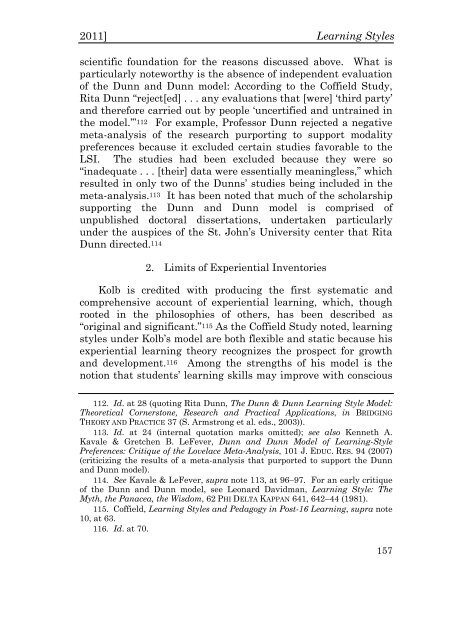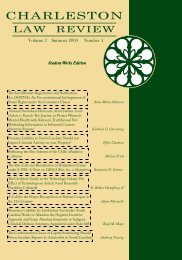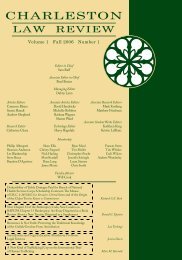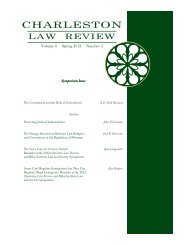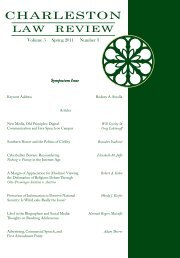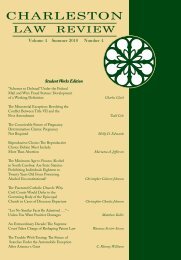Volume 5 Winter 2011 Number 2 - Charleston Law Review
Volume 5 Winter 2011 Number 2 - Charleston Law Review
Volume 5 Winter 2011 Number 2 - Charleston Law Review
Create successful ePaper yourself
Turn your PDF publications into a flip-book with our unique Google optimized e-Paper software.
<strong>2011</strong>] Learning Stylesscientific foundation for the reasons discussed above. What isparticularly noteworthy is the absence of independent evaluationof the Dunn and Dunn model: According to the Coffield Study,Rita Dunn “reject[ed] . . . any evaluations that [were] ‘third party’and therefore carried out by people ‘uncertified and untrained inthe model.’” 112 For example, Professor Dunn rejected a negativemeta-analysis of the research purporting to support modalitypreferences because it excluded certain studies favorable to theLSI. The studies had been excluded because they were so“inadequate . . . [their] data were essentially meaningless,” whichresulted in only two of the Dunns’ studies being included in themeta-analysis. 113 It has been noted that much of the scholarshipsupporting the Dunn and Dunn model is comprised ofunpublished doctoral dissertations, undertaken particularlyunder the auspices of the St. John’s University center that RitaDunn directed. 1142. Limits of Experiential InventoriesKolb is credited with producing the first systematic andcomprehensive account of experiential learning, which, thoughrooted in the philosophies of others, has been described as“original and significant.” 115 As the Coffield Study noted, learningstyles under Kolb’s model are both flexible and static because hisexperiential learning theory recognizes the prospect for growthand development. 116 Among the strengths of his model is thenotion that students’ learning skills may improve with conscious112. Id. at 28 (quoting Rita Dunn, The Dunn & Dunn Learning Style Model:Theoretical Cornerstone, Research and Practical Applications, in BRIDGINGTHEORY AND PRACTICE 37 (S. Armstrong et al. eds., 2003)).113. Id. at 24 (internal quotation marks omitted); see also Kenneth A.Kavale & Gretchen B. LeFever, Dunn and Dunn Model of Learning-StylePreferences: Critique of the Lovelace Meta-Analysis, 101 J. EDUC. RES. 94 (2007)(criticizing the results of a meta-analysis that purported to support the Dunnand Dunn model).114. See Kavale & LeFever, supra note 113, at 9697. For an early critiqueof the Dunn and Dunn model, see Leonard Davidman, Learning Style: TheMyth, the Panacea, the Wisdom, 62 PHI DELTA KAPPAN 641, 642–44 (1981).115. Coffield, Learning Styles and Pedagogy in Post-16 Learning, supra note10, at 63.116. Id. at 70.157


